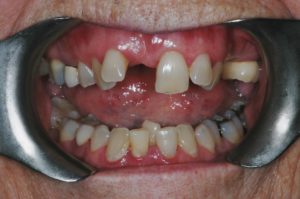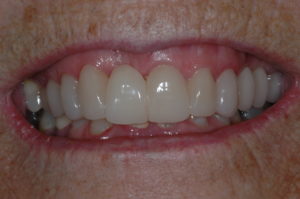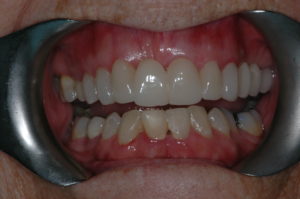This lady wanted to improve her smile without using a denture or implants and with the minimum of adjustment to her teeth.
Russell Blanchard created a smile enhancement using ceramic bridges and veneers. By using special techniques prior to preparation we were able to make an enhancement with only small amounts of alteration to her natural teeth. We also corrected her lower instanding incisor for her, which she had disliked for many years.
A great result carried out in two appointments in two weeks!
Bridges
Bridges are fixed replacements for missing teeth which are attached to one or more adjacent teeth.
The supporting teeth are known as abutment teeth and the replacement tooth is known as the pontic. Bridges can be divided into three broad categories as follows:
Conventional Bridges
These involve one or more crowned abutment teeth linked together to include at least one pontic tooth
Wing Retained Bridges
Wing retained bridges have an artificial tooth attached to a metal wing that is cemented to the back of an adjacent tooth.
These are indicated where no preparation is required to supported teeth and often as an immediate solution after extraction.
Fibre Reinforced Bridges
Fibre reinforced bridges use modern fibre reinforced composites to provide directly built “same day” bridges that are bonded to adjacent teeth.
These are an excellent option if the abutment teeth have been loosened by gum disease as the fibres can be used to strengthen these teeth as well as support the pontic.
Veneers
Porcelain veneers are thin facings of porcelain that can be cemented to the front surface of teeth to change their shape, colour, size and position.
Unlike a crown they do not cover the whole of the tooth and so require less drilling to sound tooth tissue. Porcelain veneers are very commonly used in techniques such as “smile design” where all of the visible teeth are fitted with veneers to give a balanced, harmonious, white tooth smile that extends to the corners of the mouth.
Like crowns, veneers give an excellent long term stable result for colour and shape but are more prone to chipping at the edges. As with crowns, veneers require adjustment to the underlying teeth that it is permanent. Generally when a tooth has been adjusted to have a veneer fitted it will always need to be restored with a veneer. That said the adjustment required is much less than for a crown so the risks of the tooth dying off in the long run are very much reduced.
For more information on the various treatments available to create a beautiful smile please see our StoneRock Smile Solutions pages.
For an in-depth conversation please book your free personal consultation with Russell Blanchard or Ian Kerr who will be able to assess which treatment is best for you. Please contact our Reception Team in Hawkhurst, Cranbrook, on the Kent and East Sussex borders on 01580 752202 or info@stonerock.co.uk who will be more than happy to help with any matter.



